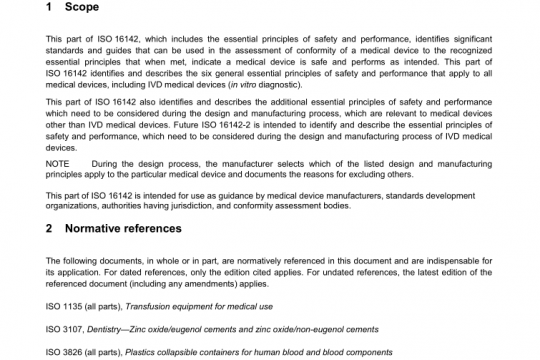AAMI TIR71 pdf free download
AAMI TIR71 pdf free download.Guidance for logging of alarm system data.
2 Normative references
ANSI/AAMI/IEC 60601-1-8, Medical electrical equipment — Part 1-8: General requirements for basic safety and essential performance — Collateral Standard: General requirements, tests and guidance for alarm systems in medical electrical equipment and medical electrical systems
3 Terms and definitions
For the purpose of this document, the terms and definitions given in ANSI/AAMI ES 60601-1 (1), ANSI/AAMI/IEC 60601-1-8, ANSI/AAMI/IEC 62366-1 121 and the following apply.
3.1 ALARM SYSTEM LOG
LOG containing events related to the ALARM SYSTEM
3.2 MEDICAL EQUIPMENT ACCESS LOG
LOG containing events related to remote access to a MEE/MES
3.3 OPERATOR-SETTiNGS LOG
LOG containing events related to changes to the OPERATOR SETTINGS of a MEEJMES
3.4 CONFIGURATION LOG
LOG containing events related to changes in the hardware or software configuration of a MEE/MES
3.5 DATA LOGGER
equipment that can be used to store LOG data
3.6 DATA STORE
data repository of a set of integrated objects; these objects are modelled using classes defined in database schemas
NOTE DATA STORE includes not only data repositories like databases: it is a more general concept that includes also flat files that can store data.
3.7 COUMUNICATOR
COM
function of the ALARM SYSTEM that generates ALARM SIGNALS to notify an OPERATOR
NOTE 1 A COM can receive an OPERATOR response.
NOTE 2 An OPERATOR response is not limited to direct OPERATOR action.
3.8 DISTRIBUTED ALARM SYSTEM
DAS
ALARM SYSTEM that involves more than one MEDICAL DEVICE intended for delivery of ALARM CONDITIONS with technical
confirmation
3.9 DISTRIBUTED ALARM SYSTEM WITH OPERATOR CONFIRMATiON
CDAS
DISTRIBUTED ALARM SYSTEM that includes the capability to receive an OPERATOR response
3.10 DISTRIBUTED INFORMATiON SYSTEM (about ALARM CONDITIONS)
DIS
system that involves more than one MEDICAL DEVICE that is intended to provide information about ALARM CONDITIONS but does not guarantee delivery of that information
3.11 INTEGRATOR
INT
function of the ALARM SYSTEM that handles communication between SOURCES and COMMUNICATORS or to other
INTEGRATORS
NOTE 1 An INTEGRATOR can direct or redirect an ALARM CONDITION to another OPERATOR.
NOTE 2 An INTEGRATOR can send the acceptance of responsibility from a COMMUNICATOR to a SOURCE.
3.12 LOG (noun)
set of data that contains information about events and related metadata
3.13 LOG (verb)
to add data to a LOG
3.14 redirection
means by which an INTEGRATOR provides a response hierarchy for directing an ALARM CONDITION to a COMMUNICATOR or redirects an ALARM CONDITION to another COMMUNICATOR
3.15 SOURCE
SRC
function that has the capability to initiate an ALARM CONDITION
NOTE The SOURCE can accept an assignment of responsibility.
4 Guidance on MEE/MES LOGS
The critical data that need to be logged relate to:
what ALARM CONDfl1ON occurred:
what data were used to determine that the ALARM CONDITION occurred;
what changed to cause the ALARM CONDITION to occur; and the state of the ALARM SYSTEM.
MEE or MES are not aware of higher order aspects of their environment, such as network topology and loading, electrical disturbances, and undetected artifacts. They can only LOG what they can detect. It is therefore incumbent upon MANUFACTURERS to perform a comprehensive failure mode analysis to determine what failures can occur and which failures offer a means of detection. The means of detection drive requirements for forensic data collection.
To improve readability and traceability, MEE/MES LOGS should include the assignment of unique component and unique event identifiers for LOG entries. Event identifiers should be assigned in such a way that one can investigate an adverse event, what Component of the system detected the adverse event, and where within the component the system detected the adverse event.AAMI TIR71 pdf download.
Other IEC Standards
-

ANSI AAMI ISO 16142-1 pdf free download – non-IVD medical devices and guidance on the selection of standards
AAMI standards list DOWNLOAD -

ANSI AAMI ISO 16142-2 pdf free download – General essential principles and additional specifc essential principles
AAMI standards list DOWNLOAD


